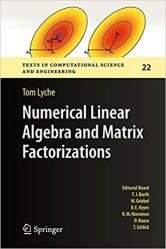 Название: Numerical Linear Algebra and Matrix Factorizations
Название: Numerical Linear Algebra and Matrix FactorizationsАвтор: Tom Lyche
Издательство: Springer
Серия: Texts in Computational Science and Engineering
Год: 2020
Страниц: 376
Язык: английский
Формат: pdf (true), epub
Размер: 19.2 MB
After reading this book, students should be able to analyze computational problems in linear algebra such as linear systems, least squares- and eigenvalue problems, and to develop their own algorithms for solving them. Since these problems can be large and difficult to handle, much can be gained by understanding and taking advantage of special structures. This in turn requires a good grasp of basic numerical linear algebra and matrix factorizations. Factoring a matrix into a product of simpler matrices is a crucial tool in numerical linear algebra, because it allows us to tackle complex problems by solving a sequence of easier ones.
The main characteristics of this book are as follows:
It is self-contained, only assuming that readers have completed first-year calculus and an introductory course on linear algebra, and that they have some experience with solving mathematical problems on a computer. The book provides detailed proofs of virtually all results. Further, its respective parts can be used independently, making it suitable for self-study.
The book consists of 15 chapters, divided into five thematically oriented parts. The chapters are designed for a one-week-per-chapter, one-semester course. To facilitate self-study, an introductory chapter includes a brief review of linear algebra.
In this book we give many detailed numerical algorithms for solving linear algebra problems. We have written these algorithms as functions in MATLAB. A list of these functions and the page number where they can be found is included after the table of contents. Moreover, their listings can be found online. As for programming issues, we often vectorize the algorithms leading to shorter and more efficient programs. Stability is important both for the mathematical problems and for the numerical algorithms. Stability can be studied in terms of perturbation theory that leads to condition numbers, see Chaps. 8, 9 and 14. We will often use phrases like “the algorithm is numerically stable” or “the algorithm is not numerically stable” without saying precisely what we mean by this. Loosely speaking, an algorithm is numerically stable if the solution, computed in floating point arithmetic, is the exact solution of a slightly perturbed problem. To determine upper bounds for these perturbations is the topic of backward error analysis.
Скачать Numerical Linear Algebra and Matrix Factorizations